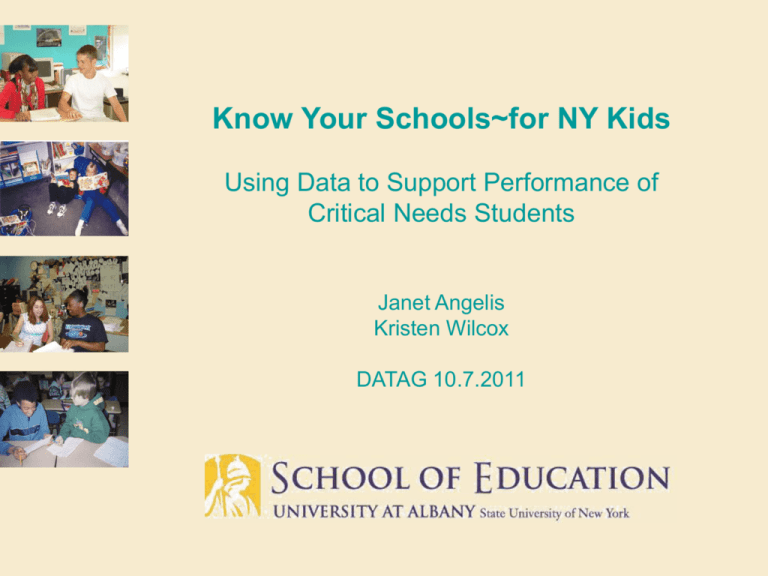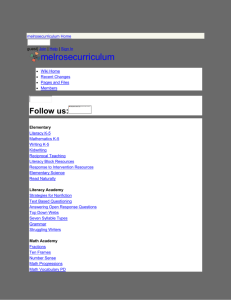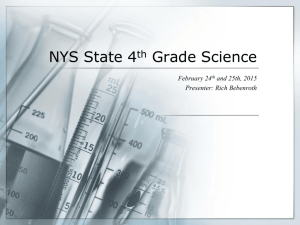Critical needs at the elementary level (2011)
advertisement

Know Your Schools~for NY Kids Using Data to Support Performance of Critical Needs Students Janet Angelis Kristen Wilcox DATAG 10.7.2011 Our Objectives • Share findings about how some schools support critical needs students to succeed • Answer your questions • Demo and provide links to resources you can use What is one thing you want to learn from us today? Use the index cards on your tables to write 1 question and hand to us NYKids The Basics • • • • Performance over time NYS Assessments (Math, ELA) Consistently higher or average performing Find the differences NYKids 2005-2011 – 5 studies • Elementary schools (2005) • Middle schools (2007) • High schools (2008) • Middle school science (2009) • Critical needs at the elementary level (2011) Critical Needs Sample • ELA and Math, 2007-9 • Grades 3-6 • 5 critical needs groups • Regressed against school size, stu stability, ethnicity, SES • 10 HP, 5 AP Mean Z Score, Higher Performers +1.86 Mean Z Score, Average Performers -0.03 CN Sample cont. • Favor poverty (F/RL) – 73% of total sample > NYS average • Primarily urban, exurban HPs (APs ~) • Open admissions • NYS average per pupil expenditures CN Sample cont. HP Elementary Schools, Critical Needs • • • • • • Malverne UFSD, Davison Avenue ES (Nassau) Mount Vernon City SD, Lincoln ES (Westchester) New Rochelle City SD, Columbus ES (Westchester) Pine Bush Central SD, Pakanasink ES (Orange) Port Chester-Rye UFSD, John F. Kennedy ES (Westchester) • • • • Rochester City SD, Dr. Charles T. Lunsford School 19 (Monroe) Roosevelt UFSD, Centennial Avenue ES (Nassau) Utica City SD, Martin Luther King Jr. ES (Oneida) Valley Central SD, Maybrook ES (Orange) Valley Stream 30 UFSD, Forest Road ES (Nassau) Dist. Schl Grds Tot # F/RL EL AA H/Lt Wht Oth Roch City Schl 19 K-6 309 98 12 Utica City MLK K-5 273 94 New Roch Columbus K-5 816 PC-Rye JFK K-5 Roosevelt Centennial M. Vernon 2 94 2 1 $18,956 11 52 27 11 10 $14,940 78 31 8 82 8 2 $21,959 725 78 55 10 86 3 2 $18,413 K-5 440 66 30 54 45 0 0 $24,585 Lincoln K-6 758 60 15 49 24 21 6 $22,133 P. Bush Pakanasink K-5 483 51 3 25 31 36 8 $16,758 Valley Ct. Maybrook K-5 235 42 3 15 20 62 3 $15,941 Malverne Davison K-4 325 34 8 37 25 30 8 $26,127 VS 30 Forest Rd. K-6 272 17 8 39 17 6 40 $20,483 K-12 2.7 m 48 8 19 22 50 8 $19,381 NYS Except for PPE (2008-9 data), all data are from 2009-10. PPE* Methods • Made 2-day site visits (2-person teams) • Interviewed teachers and administrators – 211 total • • • • Collected documents* Analyzed, wrote a case study for each site* Analyzed, wrote cross-site analysis** Analyzed, created best practice framework* * All available at: www.albany/nykids http://knowyourschoolsny.org (see handout) ** (end of Oct – see postcard) What Works for Diverse and Special Needs Students Best practices from higherperforming elementary schools What Works for Diverse and Special Needs Students Overall Findings: What Works for Critical Needs Students • Close Engagement with and Understanding of the Population • Literacy- and Technology-Enriched Instruction • Enlightened Approach to Curriculum and Data • Fluid Adaptation and Deployment of Resources What Works for Diverse and Special Needs Students Close Engagement with and Understanding of the Population • Communal Stances about Difference • Deliberate and Effective Outreach to Parents • Consistent Vertical Collaboration You have to know your population and teach your population, despite the outside factors. You have to know who’s in front of you. – John F. Kennedy teacher What Works for Diverse and Special Needs Students Our work with families is key. Our faculty and staff understand this. We all stress the notion that “We are family” with our school community. - Centennial Avenue principal Principals have individual meetings with classroom teachers and the reading teacher to review progress and determine if what they are doing is working or they need to switch. – Valley Stream 30 (Forest Road) administrator What Works for Diverse and Special Needs Students AP Engagement and Understanding of Population HP Ethic of care and nurture, yet accountability for students’ emotional and social growth and academic achievement is not. School seen as a “family,” cooperation expected; all employees take responsibility for children’s emotional and social growth and achievement. Parent connections weak and attributed to community apathy regarding schooling or language deficiencies among parents. Teachers consistently forge parent relationships; these facilitated through school-level initiatives that recognize and celebrate diversity. Dialogue (plus action) from teacher to school to district and the reverse infrequent and/or inconsistent, not necessarily centered on student achievement. Discussions between teacher leaders and principals consistently inform instructional and other resource allocation changes from classroom to district. Rochester’s School 19 Created a Family Grades K-6 309 stu. 98% FR/L 94% AA 98% avg NYS PPE What Works for Diverse and Special Needs Students Literacy- and Technology-Enriched Instruction • Literacy-Building Early, Intensively and Coherently • Literacy for English Learners • Technology-Enhanced Instruction I strongly believe that a student must know how to read before they enter Grade 3. We do everything in our power within the classroom and within AIS to reach this goal. Direct instruction, AIS, after school tutoring, as well as computer-aided instruction are the delivery systems we use to help our students read before entering Grade 3. - Martin Luther King Jr. teacher What Works for Diverse and Special Needs Students The dedicated 90-minute literacy block with a structured mini lesson, reader’s workshop, learning centers, guided reading, and writing opportunities has been a key reform. I think it has benefited our students the most and strengthened our ELA instructional program. – Centennial Avenue teacher Using the same language, making sure that if we’re using an approach in second grade, that the same language in terms of strategies is used the next year. If you don’t do that, then you spend the first three months teaching [students] to use your strategies. - Malverne (Davison Ave) special education director What Works for Diverse and Special Needs Students AP Literacy- and Technology-Enriched Instruction HP No clear and consistent approach to literacy instruction apparent from teacher to teacher and grade level to grade level. Balanced strategies build literacy intensively early in the elementary years and with consistency from class to class and grade level to grade level. ESL instruction typically pull out and seen as discrete from mainstream instruction. Mainstream teachers specifically adapting instruction for ELs and/or providing native language instruction to improve literacy development. Technology typically controlled by the teacher and not used in a strategic way to target needed literacy skills. Technology used to target specific skills at level and pace of student need, continually monitor performance, supplement instruction for special needs students and ELs, and extend instruction to the home. K-5 235 stu. 42% F/RL 15% AA 20% H/L 82% avg NYS PPE Maybrook Stresses Literacy Instruction What Works for Diverse and Special Needs Students Enlightened Approach to Curriculum and Data • Curriculum Enlightenment • Data Literacy • Adaptations for Critical Needs Students [I attribute our success to] overall curriculum alignment, which is district wide in terms of setting clear alignment maps of what students should know and be able to do. These are consistently upheld school wide, district wide, and classroom wide. – Valley Stream 30 (Forest Road) administrator What Works for Diverse and Special Needs Students There’s a real understanding of what the achievement gap is, where the students are really underperforming, and that comes from a strong ability from the principal and assistant principal to really understand the state data. - New Rochelle (Columbus) administrator [Building] data literacy . . . extinguished the ideas and the perceptions that kids can’t learn because they just don’t have it, and because they just can’t do it. - Port Chester-Rye (John F. Kennedy) administrator What Works for Diverse and Special Needs Students AP Approach to Curriculum and Data HP Curriculum revision seen as product oriented, something finished until scheduled for revisiting; curriculum may be out of sync with programs and materials. Curriculum revision seen as a continuing, revelatory process that includes revamping, rethinking, and retooling to deliver curricula in new ways. Classroom performance data seen as disconnected from what is important, so results not effectively used; discussions of data between teachers and administrators infrequent and optional. Variety of useful performance data generated regularly, shared vertically, and acted upon to inform instructional changes and curriculum revision. No specific adaptations for special education and ESL students articulated in the curriculum. Curriculum adapted to the needs of special education and ESL students. Centennial Ave. Unifies the Curriculum K-5 440 stu 66% F/RL 30% EL 54% AA 45% Hisp. 125% avg. NYS PPE What Works for Diverse and Special Needs Students Fluid Adaptation and Deployment of Resources • Adaptability Enacted • Extensive Range of Interventions • Pursuit and Targeting of Funding We’re never really sure when we pilot or adopt an initiative or program – a training or approach – how effective it will be. . . . We are even [willing to] take a half step backward if [a program offers] the prospect of being able to take two steps forward. – New Rochelle (Columbus) administrator What Works for Diverse and Special Needs Students We look at what the child needs and figure out ways to meet those needs without feeling that we need to label. . . . Let’s meet the needs and monitor how they progress. . . . We first look at the need and the services and provide it [label or not]. - Columbus teacher There’s no specific student-teacher ratio; it’s more of group instruction, based on needs. It’s very amorphous, with a tremendous amount of auxiliary staff and a high allocated budget to retain those teachers. - Pine Bush (Pakanasink) administrator What Works for Diverse and Special Needs Students AP Adapting and Deploying Resources HP ESL and special education not as inclusionary as it could be; if in transition to more inclusionary, struggling with scheduling and belief constraints. Flexible stance toward the use of specialists, instructional space, and time maximizes levels of inclusion for EL and special needs students. RTI in infancy and/or resistance to RTI evident. Extensive array of intervention strategies used, including effective use of RTI. Little evidence of successfully garnering grant support for extended day interventions or other special support targeted to ELs and/or special needs students. Funding for extra support targeted specifically to ELs and special needs students pursued, successfully garnered, and well appropriated. JFK (Port Chester) Targets Resources JFK Other top performers, similar schools K-5 725 stu. 78% F/RL 55% EL 10% AA 86% Hisp. 95% avg. NYS PPE % ELL What would you like to know? http://knowyourschoolsny.org What Works for Diverse and Special Needs Students Also: school size, % taking test, size of grade, etc. Grade 3 ELA, 2010 What Resources Are Available for Schools? Tools to Assess, Plan Improvement www.albany.edu/nykids http://knowyourschoolsny.org • • • • • • • Case reports, all HP schools Cross-case reports, each study Best practice frameworks Documentary evidence Key word searches Self-assessments NEW – Institutes to support school teams to use these resources to use data to plan, monitor, improve (SMART Goals) Questions? More info? • jangelis@albany.edu • Postcards on table • Websites on your handout







